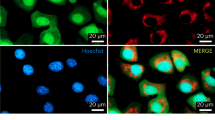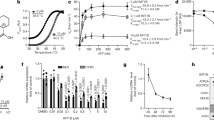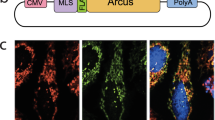Abstract
Mitochondrial DNA (mtDNA) is the only extrachromosomal DNA in humans. It is a small (16.5kb) genome which encodes 13 essential peptides of the respiratory chain, two rRNAs and 22 tRNAs. Defects of this genome are now recognized as important causes of disease and may take the form of point mutations or rearrangements1–3. There is no effective treatment for patients with mtDNA mutations4. In the majority of patients with mtDNA defects, both mutant and wild-type molecules are present in the same cell — a phenomenon known as intracellular heteroplasmy. In addition, in the presence of heteroplasmy there is a threshold whereby a certain level of mutant mtDNA is necessary before the disease becomes biochemically and clinically apparent5–7. Based on the presence of heteroplasmy and the recessive nature of these mutations, we believe it will be possible to treat patients by selectively inhibiting the replication of the mutant mtDNA, thereby allowing propagation of only the wild-type molecule. To confirm the validity of such an approach we synthesized peptide nucleic acids (PNAs) complementary to human mtDNA templates containing a deletion breakpoint or single base mutation, both mutatins well documented to cause disease. Using an in vitro replication run-off assay under physiological conditions, the antigenomic PNAs specifically inhibited replication of mutant but not wild-type mtDNA templates. Furthermore, we have shown uptake of these PNAs into cultured human myoblasts. We believe that we have therefore established the potential value of antigenomic PNA therapy for patients with heteroplasmic mtDNA disorders.
This is a preview of subscription content, access via your institution
Access options
Subscribe to this journal
Receive 12 print issues and online access
$209.00 per year
only $17.42 per issue
Buy this article
- Purchase on Springer Link
- Instant access to full article PDF
Prices may be subject to local taxes which are calculated during checkout
Similar content being viewed by others
References
Wallace, D.C. Diseases of the mitochondrial DNA Annu. Rev. Biochem. 61, 1175–1212 (1992).
Johns, D.R. Mitochondrial DNA and disease. New Engl. J. Med. 333, 638–644 (1995).
Wallace, D.C. Mitochondrial genetics: a paradigm for aging and degenerative diseases? Science 256, 628–632 (1992).
Chrzanowska-Lightowlers, Z.M.A., Lightowlers, R.N. & Turnbull, D.M., Therapy for mitochondrial DNA defects: is it possible? Gene Therapy 2, 311–316 (1995).
Boulet, L., Karpati, G. & Shoubridge, E.A. Distribution and threshold expression of the tRNALys mutation in skeletal muscle of patients with myoclonus epilepsy and ragged-red fibres (MERRF). Am. J. Hum. Genet. 51, 1187–1200 (1992).
Chomyn, A. et al. MELAS mutation in mtDNA binding site for transcription termination factor causes defects in protein synthesis and in respiration but no change in levels of upstream or downstream mature transcripts. Proc. Natl. Acad Sci. USA 89, 4221–225 (1992).
King, M.P., Koga, Y., Davidson, M. & Schon, E.A. Defects in mitochondrial protein synthesis and respiratory chain activity segregate with the tRNALeu (UUR) mutation associated with mitochondrial myopathy, encephalopathy, lactic acidosis and stroke-like episodes. Mol. Cell. Biol. 12, 480–490 (1992).
Clayton, D.A. Nuclear gadgets in mitochondrial DNA replication and transcription. Trends Biochem. Sci. 16, 107–111 (1991).
Clayton, D.A. Transcription and replication of animal mitochondrial DNAs. Int. Rev. Cytol. 141, 217–232 (1992).
Nielsen, P.E., Egholm, M., Berg, R.H. & Buchardt, O. Sequence-selective recognition of DNA by strand displacement with a thymine-substituted polyamide. Science 254, 1497–1500 (1991).
Egholm, M., Buchardt, O., Nielsen, P.E. & Berg, R.H. Peptide nucleic acids (PNA). Oligonucleotide analogues with an achiral peptide backbone. J. Am. Chem. Soc. 114, 1895–1897 (1992).
Egholm, M. et al. PNA hybridizes to complementary oligonucleotides obeying the Watson-Crick hydrogen-bonding rules. Nature 365, 566–568 (1993).
Demidov, V.V. et al. Stability of peptide nucleic acids in human serum and cellular extracts. Biochem. Pharmacol. 48, 1310–1313 (1994).
Holt, I.J., Harding, A.E. & Morgan-Hughes, J.A. Deletions of muscle mitochondrial DNA in patients with mitochondrial myopathies. Nature 331, 717–719 (1988).
Moraes, C.T. et al. Mitochondrial DNA deletions in progressive external opthalmoplegia and Kearns-Sayre syndrome. New Engl. J. Med. 320, 1293–1299 (1989).
Schon, E.A. et al. A direct repeat is ahotspot for large-scale deletion of human mitochondrial DNA. Science 244, 346–349 (1989).
Orum, H. et al. Single base pair mutation analysis by PNA directed PCR clamping. Nucleic Acids Res. 21, 5332–5336 (1993).
Wong, T.W. & Clayton, D.A. Isolation and characterization of a DNA primase from human mitochondria. J. Biol. Chem. 260, 11530–11536 (1985).
Shoffner, J.M. et al. Myoclonic epilepsy and ragged-red fiber disease (MERRF) is associated with a mitochondrial DNA tRNALys mutation. Cell 61, 931–937 (1990).
Silvestri, G. et al. Clinical features associated with the A→G transition at nucleotide 8344 of mtDNA (“MERRF mutation”;). Neurology 43, 1200–1206 (1993).
Curth, U. et al. Single-stranded-DNA-binding proteins from human mitochondria and Escherichia coli have analogous physicochemical properties. Eur. J. Biochem. 221, 435–443 (1994).
Hoke, G.D., Pavco, P.A., Ledwith, B.J. & Van Tuyle, G.C. Structural and functional studies of the rat mitochondrial single strand DNA binding protein P16. Arch. Biochem. Biophys. 282, 116–124 (1990).
Genuario, R. & Wong, T.W. Stimulation of DNA polymerase gamma by a mitochondrial single-strand DNA binding protein. Cell. Mol. Biol. Res. 39, 625–634 (1993).
Williams, A.J. & Kaguni, L.S. Stimulation of Drosophilamitochondrial DNA polymerase by single-stranded DNA-binding protein. J. Biol. Chem. 270, 860–865 (1995).
Lohman, T.M. & Overman, L.B. Two binding modes in Escherichia colisingle strand binding protein-single stranded DNA complexes. J. Biol. Chem. 260, 3594–3603 (1985).
Vestweber, D. & Schatz, G. DNA-protein conjugates can enter mitochondria via the protein import pathway. Nature 338, 170–172 (1989).
Seibel, P. et al. Transfection of mitochondria: strategy towards a gene therapy of mitochondrial DNA diseases. Nucl. Acids Res. 23, 10–17 (1995).
Sanger, F., Nicklen, S. & Coulson, A.R. DNA sequencing with chain terminating inhibitors. Proc. Natl. Acad. Sci. USA 74, 5463–5467 (1977).
Torroni, A. et al. About the “Asian”-specific 9-bp deletion of mtDNA. Am. J. Hum. Genet. 57, 507–508 (1995).
Anderson, S. et al. Sequence and organisation of the human mitochondrial genome. Nature 290, 457–465 (1981).
Author information
Authors and Affiliations
Corresponding author
Rights and permissions
About this article
Cite this article
Taylor, R., Chinnery, P., Turnbull, D. et al. Selective inhibition of mutant human mitochondrial DNA replication in vitro by peptide nucleic acids. Nat Genet 15, 212–215 (1997). https://doi.org/10.1038/ng0297-212
Received:
Accepted:
Issue Date:
DOI: https://doi.org/10.1038/ng0297-212
This article is cited by
-
Mitochondrial DNA m.3243A > G heteroplasmy affects multiple aging phenotypes and risk of mortality
Scientific Reports (2018)
-
Current approaches to reduce or eliminate mitochondrial DNA mutations
Science China Life Sciences (2016)
-
Specific elimination of mutant mitochondrial genomes in patient-derived cells by mitoTALENs
Nature Medicine (2013)
-
Mitochondrial-targeted DNA delivery using a DF-MITO-Porter, an innovative nano carrier with cytoplasmic and mitochondrial fusogenic envelopes
Journal of Nanoparticle Research (2012)
-
Enhanced annealing of mismatched oligonucleotides using a novel melting curve assay allows efficient in vitro discrimination and restriction of a single nucleotide polymorphism
BMC Biotechnology (2011)



